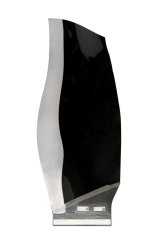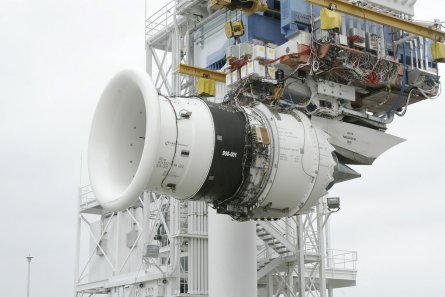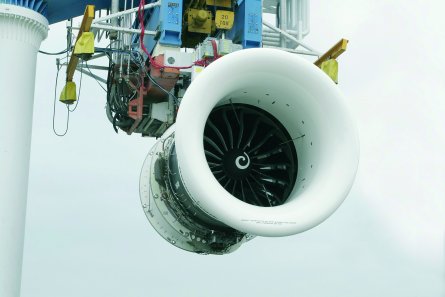By Guy Norris in Evendale
To meet Boeing’s ambitious low- cost, high-efficiency targets for the 787, General Electric reached deep into its technology toolbox to produce the GEnx. Although initial details of the engine’s architecture and even of its radical large-scale composite construction came to light in 2004, it is only now that GE is starting to talk about the materials innovations that lie at the heart of its new turbofan.
 |
|---|
| Composite blade production is ramping up for GEnx and GE90 |
Designed to succeed the popular CF6, the GEnx ran for the first time at GE’s Peebles test site in Ohio on 19 March. Building directly on the experience gained with the successful GE90 powering the Boeing 777, the GEnx has gone further by pioneering the large-scale use of composites in the fan case, as well as the fan itself. The 9.5:1 bypass ratio engine incorporates a 2.82m (9.2ft)-diameter fan made up of black, highly swept composite blades with titanium leading-edge cuffs.
Architecturally, the GEnx marks the introduction of counter-rotating high- and low- pressure (HP/LP) spools; an advanced 10-stage HP compressor based on the aerodynamics demonstrated on the “Core 7” development version of the GE90-94B, and a low blade-count, seven-stage LP turbine. The LP compressor has four stages while the HP turbine has two.
At its core the engine has a twin annular pre-mixing swirler (TAPS) combustor that pre-mixes the air and fuel before they are burned. This is designed to allow the combustion process to be more complete at lower temperatures. The lower the temperature, the lower the NOx emissions, and GE hopes to gain around a 30% improvement over the CF6 by using TAPS. The heart of the combustor is a pair of annular fuel/air “swirls” that pre-mix the two before funnelling the mixture to the relatively conventional combustor. The inner swirler is used for low-thrust requirements in idle and taxiing, while the outer swirler engages for higher thrust settings.
Making savings
Externally, the engine closely resembles a smaller GE90, and for the first time on any jet engine it is possible to see relatively large amounts of daylight through the fan stage, which incorporates only 18 blades, compared with 22 in the fan of the GE90 and 36 in the CF6. The move was driven by the need for better efficiency and less weight, and it reduces noise by cutting losses due to “scrubbing” or aerodynamic interaction with the wake of the preceding blade.
The blades are made in San Marco, Texas by CFAN, a joint GE/Snecma concern that is now gearing up to handle the forthcoming production loads of not only the bigger GE90, but also the GEnx-1B70 for the 787, GEnx-2B67 for the 747-8 (for which the engine was selected as sole source in 2005) and whatever revised version of the GEnx-1A72 is expected to be selected for the Airbus A350/A370. The composite fan case, introduced as a way of saving around 160kg (350lb) per engine, is being produced by GKN Aerospace at its Alabama Aerostructures Site in Tallassee.
The GEnx fan case is made using a composite fibre braid, and involves laying down three triaxial braids in a weave mixed with biaxial braids. A slightly thicker weave is laid down for the centre section to eliminate the need for the traditional Kevlar containment case used in previous engines. GE believes that getting rid of the Kevlar with an all-composite case will not only result in better resilience to foreign object damage, but will also see a reduction in maintenance concerns – the interface between the Kevlar and the aluminium fan liner often being a trouble spot for moisture and corrosion.
Other composite applications developed with the GE Research Center include fan platforms, which sit in the interstitial spaces between the fan blade roots, and variable bypass vane air ducts. Potential composite applications for the future could include the spinner, hybrid vane and structural cowl, says the company.
GKN Aerospace is also supplying a one-piece acoustic liner that showed significant noise benefits in recent Quiet Technology Demonstrator tests on a 777-300ER. The liner, which is made up of a Nomex honeycomb core wrapped in a glassfibre epoxy surround, attenuates the distinctive “buzz saw” noise made by supersonic shocks from the fan blades on take-off and at high power settings, as well as other tones emanating from the fan at all frequencies. The liner also helps attenuate the noise generated by the fan flow interactions with the outlet guide vanes.
 |
|---|
The trailing edge of the fan duct will also be equipped with chevrons, which cut down on noise by speeding up the mixing of the bypass flow with the ambient air. By promoting mixing, the “shearing” or ripping effect between the two air masses is reduced, helping cut back on another classic source of jet noise. The chevrons, which made their commercial debut on later versions of the CF34 powering larger regional jets, made their first appearance on the second GEnx certification test engine, 956-002, which enters the test programme this month.
 |
|---|
Material innovation
Although the extensive use of composites has grabbed the headlines for the GEnx, a less obvious – but just as dramatic – breakthrough lies in its use of an intermetallic compound called titanium aluminide (TiAl) in the LPT blades. Although the use of gamma TiAl materials has been explored for several years around the world, particularly through the US Integrated High Performance Turbine Engine Technology (IHPTET) CAESAR (component and engine structural assessment research) programme, its applications have so far been limited largely to protective coatings and discrete parts in some military engines.
“After 20-30 years of research it is a key breakthrough to use this material in this way,” says GE Aircraft Engines materials and process engineering general manager Robert Schafrik. The TiAl is being used in the sixth and seventh stages of the LPT, after proving its robustness on more than 1,500 cycles in a CF6. “For us to step up and bet the engine on this technology is a big deal,” says Schafrik, who adds: “If it has only 50% of the weight of nickel alloys you’ve got to believe this is here to stay.”
Having opted to use TiAl in the engine, GE is now working closely with suppliers such as Portland, Oregon-based Precision Castparts (PCC) and other major parts and materials partners. “The main thrust is now working the supply chain, and we feel the technology itself is fine,” says Schafrik. Aware of the increasing strategic importance of materials such as TiAl and other advanced alloys, PCC has just completed the acquisition of Special Metals (SMC), a West Virginia-based manufacturer of high-performance nickel-based alloys and super alloys. PCC says the acquisition “will provide Precision Castparts with an internal supply of nickel-based billet for its forged products operations, as well as strengthening and diversifying PCC’s sales profile”.
Other intermetallic applications will include blades made from niobium silicide (NbSi), which Schafrik says will allow between 45kg and 135kg of weight reductions at material strengths equal to or more than current nickel-based high-performance materials such as Rene 80 (R80). “For 20 years everyone has been looking at what to do next for high-pressure turbines beyond nickel super alloys and NbSi is what we’ve settled on,” he says. Aside from significantly lower weight, the material also allows substantial cooling flow reductions and GE will be able to make use of current manufacturing sites for casting and coating.
“We’ve taken the first generation of NbSi and we are now in the process of looking at how we can qualify it for an engine application,” adds Schafrik. “We also have a second generation of alloys we’re thinking about.” Projecting out to the future GE estimates NbSi-made LPT blades could appear around 2012, with structurally more complex HPT blades following by around 2015.
Other advanced alloys used in the rotors of the GEnx include a nickel-based powder-metal superalloy R104, which provides “higher creep strength, particularly at the rim, where you really measure creep and fatigue”, says Schafrik, who says the company expects a 50% improvement in rotor rim fatigue life over previous materials. The material, which was also used in the GE-Pratt & Whitney Engine Alliance GP7200, was developed jointly with NASA and P&W, and has improved forging and billet uniformity that enhances the manufacturing quality of the finished material.
Schafrik says the material properties are improved “because we get the right microstructure through isothermal forging. It’s a very slow forging time.” He adds that R104 is “the latest and greatest”.
Another area of focus is in ceramic matrix composites (CMCs), which offer less weight and better performance with reduced cooling for future applications. Tests of a CMC made using a silicon melt infiltration process have shown the material not only withstands higher temperatures than traditional metals, but it also has better fracture and crack resistance than conventional ceramics and is only one-third the weight.
“We are pretty serious about ceramic and polymer composites, and we have a CMC vane on the F136 [alternate engine for Lockheed Martin F-35] so we think the time is right to introduce it on a commercial application,” says Schafrik. GE Energy and Goodrich have been identified as material suppliers and “significant” engine tests are planned in 2006-8 with CMCs in a “wide range of hot-section components”, ranging from combustor liners and HP spool blades to exhaust parts, adds the company.
“Finally we think we have a recipe. There is an infinite number of materials we could work on, but what we’re driven by is the requirements,” says Schafrik. As a potential combustor liner, the material weighs half the conventionally used alloy material, yet has a 1,200˚C (2,200˚F) capability, allowing a 20% reduction in NOx, as well as requiring only 50% of the normal amount of cooling air. Similarly, as a vane or a blade, the CMC unit weighs 70% less than the equivalent metal part, with the same 1,200˚C operating temperature capability and reduced cooling needs.
Trials ahead
GE is now getting a chance to test all these advances as the first GEnx-1B70 engines enter the rigorous certification programme. Despite the advanced features, GEnx general manager Tom Brisken says “operators are getting more confident. At first, when we started telling them about the composite fan case, the TAPS and TiAl, some were quite concerned, but after two and a half years of technology demonstration maturation programmes we have satisfied them. We have performed more than 7,000h of technology component testing on 50 different maturation tests,” he adds.
To ensure the composite fan case design is efficient and not too heavy, Brisken says a further test is planned using a thinner plied version. “We are just about to run a full-scale test, although we might actually fail this. We want to see how far down we can go, as we’ve taken it down a bit thinner. But safety is our number one concern,” he adds.
Overall, the plan involves a dedicated core, engine 000, plus seven full-test powerplants. Engine 000 will be used for HP turbine stress evaluation as well as HP compressor performance measurement, and is due to become the fourth unit to enter the programme late in the third quarter. The first engine to test, 001, is set to run through to the second quarter of next year and is aimed at assessing performance, crosswind work and vibration. This engine is also set to be sacrificed in the destructive fan “blade-out” test in 2007.
The chevron-equipped engine 002 is also the first to be fitted with all the production hardware and, as well as having the full nacelle, will be fitted with a standard oil cooler, thrust reverser and starter-generator unit. It will be used for emissions and LP turbine stress work, and will also be the first to be measured for key acoustic levels. Engine 002 is also dedicated to endurance running and, with a scheduled completion date in the fourth quarter of 2007, is one of the longest-serving engines in the certification programme.
Engine 003 is set to cover vibration characteristics, as well as perform bird- strike, ice and water ingestion tests. The engine, which will also perform endurance cycles, is set to run from the third quarter for almost a full year. Engine 004 will perform the all-important 150h “triple redline” block test, which sees the engine run for sustained periods in simulated flight cycles up to 6h, at operating limits well beyond normal level.
Engine 005 will be the first GEnx of any variety to become airborne when it flies on GE’s specially converted Boeing 747-100 flying testbed (FTB) in the first quarter of 2007. The aircraft is also being modified to take the massive amounts of electrical power that will be generated by the GEnx. Adapted for the non-bleed, more-electric requirements of the 787, the engine will produce more than a megawatt of electricity compared with around 60kV for current engines of equivalent power.
The sixth test engine will be used to assess the initial maintenance inspection interval for the GEnx, as well as be used for a 3,000-cycle extended twin-engine operations (ETOPS) test. The target is for the GEnx to achieve 25,000h time-on-wing between overhauls (TBO), versus the 18,000h achieved by the CF6-80C2. Overall, GE is aiming for around a 30% increase in TBO versus the -80C2 – a large slice of the 32% maintenance cost savings at maturity targeted by Boeing for the 787 as a whole. Meanwhile, the ETOPS tests will form a crucial element of Boeing’s plan to have the 787 certificated for 330min ETOPS at entry into service, compared with the pioneering effort that went into clearing the 777 for 180min ETOPS “out of the box” just over a decade ago. The seventh engine, which is set to join the programme late in 2006, will undergo emissions and full icing testing.
On dock
For the all-important 787 flight-test phase, GE plans to have the first shipset of compliance engines “on dock” at Peebles in September 2007 to coincide with the anticipated award of US FAA Part 33 engine certification. The first spare test engine is due to be delivered to Boeing around October. Flight tests on the 787 are then due to begin, with European engine certification due in the first quarter of 2008 and US Part 25 aircraft certification for the GE-powered 787 due around mid-second quarter 2008. Entry into service is scheduled at the end of June 2008.
Source: Flight International
















